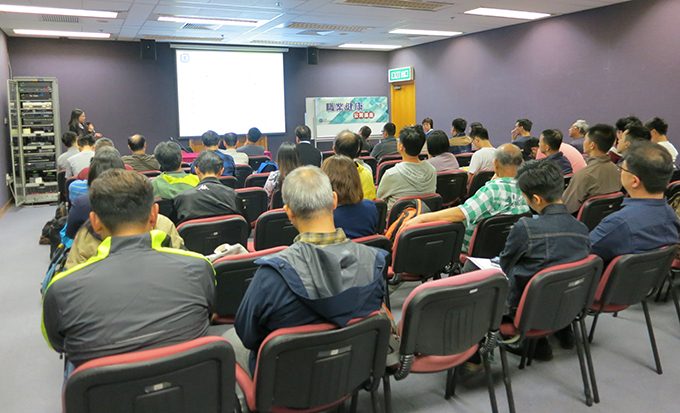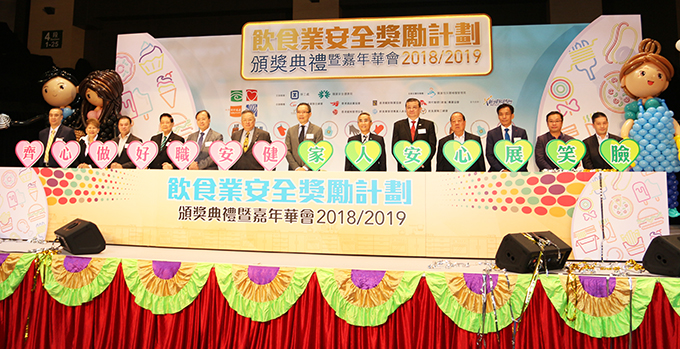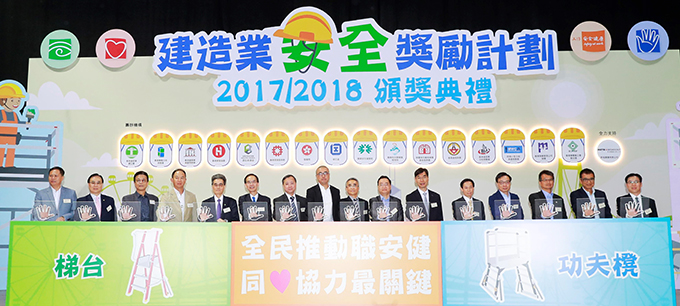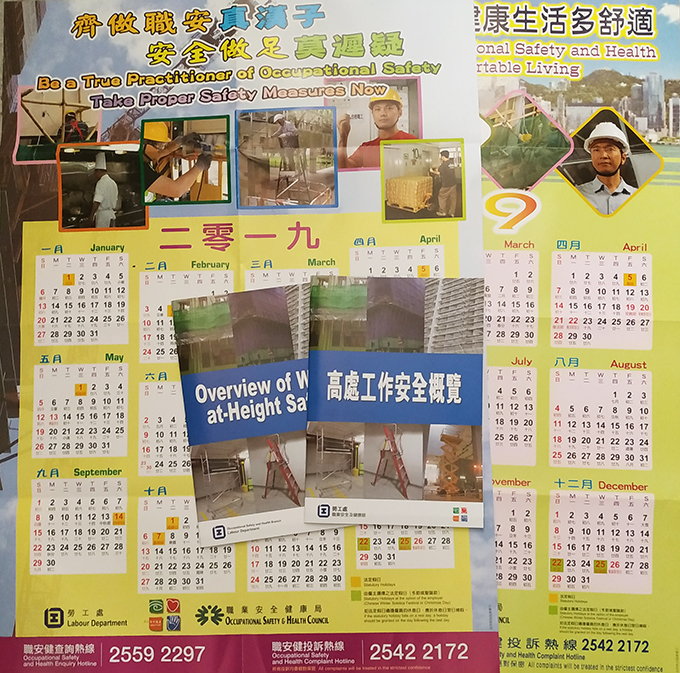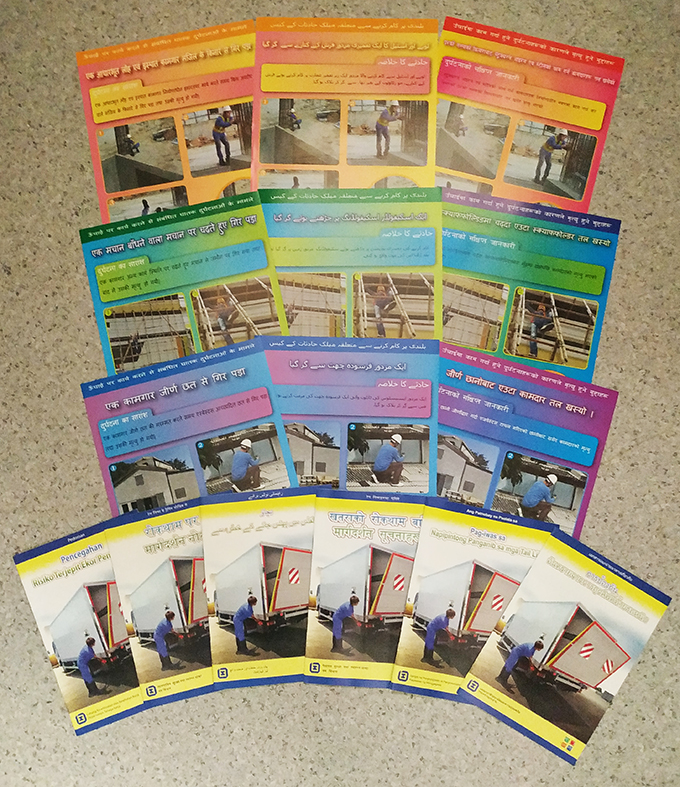Chapter 4 Safety and Health at Work
The Programme of Safety and Health at Work
www.labour.gov.hk/eng/osh/content.htmThe Occupational Safety and Health Branch is responsible for the promotion and regulation of safety and health at work. The objective of the Programme of Safety and Health at Work is to ensure that risks to people’s safety and health at work are properly managed and reduced to the minimum through the three-pronged strategy of inspection and enforcement, education and training, as well as publicity and promotion. More specifically, we achieve the objective by:
- providing a legislative framework to safeguard safety and health at work;
- enforcing compliance with the Occupational Safety and Health Ordinance (OSHO), the Factories and Industrial Undertakings Ordinance (FIUO), the Boilers and Pressure Vessels Ordinance (BPVO) and their subsidiary regulations through inspection of workplaces to ensure that the requirements are complied with;
- investigating accidents and occupational health problems at workplaces and giving advice to employers and employees on how to reduce existing workplace hazards;
- offering advice to owners in the design and layout of workplaces, and in the implementation of safety programmes in workplaces;
- providing to employers, employees and the general public appropriate information and advice to promote knowledge and understanding of occupational safety and health (OSH); and
- organising promotional programmes and training courses to enhance safety awareness of the workforce.
The OSHO protects employees’ safety and health at work generally in all branches of economic activities. It is a piece of enabling legislation that empowers the Commissioner for Labour to make regulations prescribing standards for general working environment as well as specific safety and health aspects at work.
The FIUO regulates safety and health at work in industrial undertakings, which include factories, construction sites, cargo and container handling areas, as well as catering establishments.
The BPVO aims at regulating the standards and operation of boilers and pressure vessels, including steam boilers, steam receivers and air receivers.
Our Work and Achievements in 2018
Work Safety Performance
Through the concerted efforts of all parties concerned, including employers, employees, contractors, safety practitioners, and the Government and public sector organisations, Hong Kong’s work safety performance has been improving.
The number of occupational injuries in all workplaces in 2018 stood at 35 964, representing a drop of 9.1% from 39 579 in 2009, while the injury rate per thousand employees decreased to 11.8, down by 21.6% when compared to 15.0 in 2009. The number of industrial accidents for all sectors went down to 10 602, representing 22.0% drop when compared to 13 600 in 2009. The accident rate per thousand workers for all sectors decreased to 16.5, down by 33.0% when compared to 24.6 in 2009.
In 2018, there were 3 541 industrial accidents in the construction industry, representing an increase of 28.5% when compared to 2 755 in 2009. The accident rate per thousand workers, however, decreased from 54.6 to 31.7, down by 42.0%.
Occupational Diseases
In 2018, there were 400 cases of confirmed occupational disease, among which occupational deafness, silicosis and tenosynovitis of the hand or forearm were the most common.
Key Indicators of Work
Some key indicators of work of this programme area are shown in Figure 4.1.
Inspection and Enforcement
To ensure safety and health at work, we inspect workplaces, monitor health hazards, investigate work accidents and occupational diseases, register and inspect boilers and pressure equipment and advise on measures to control hazards or prevent accidents.
We conduct promotional visits to give advice to employers on the prevention of accidents and encourage them to proactively adopt a self-regulatory approach in managing risks at the workplace. We also conduct enforcement inspections to various workplaces to ensure that duty-holders have observed relevant statutory requirements stipulated in safety legislation. We adopt a risk-based approach to adjust the intensity of inspection and enforcement efforts from time to time to effectively combat unsafe acts.
In 2018, we continued to place workplaces with poor safety performance under close surveillance. Improvement notices or suspension notices were issued when necessary to secure speedy rectification of irregularities, or to remove imminent risks to lives. In 2018, we also conducted 15 special enforcement operations targeting specific workplace hazards or workplaces with higher risk work processes, including new works; repair, maintenance, alteration and addition (RMAA) works; lift installation, repair and maintenance works; electrical works; bamboo scaffolding; sea-based construction works; waste management works; catering; logistic, cargo and container-handling industries as well as fire and chemical safety. In these 15 operations, a total of 15 897 workplaces were inspected, with 1 199 improvement notices and 184 suspension notices issued, and 1 026 prosecutions initiated. Besides, we launched 19 in-depth surprise inspections to work sites with higher risk processes or poor safety performance. A total of 350 suspension/improvement notices were issued and 218 prosecutions initiated. In order to enhance safety performance of public work projects, representatives of the Labour Department (LD) participated in 383 site safety management committee meetings of public work projects and safety advice, in particular concerning work processes of higher risk, were provided to the contractors and relevant duty holders.
We conduct investigations into complaints concerning unsafe conditions or malpractices in workplaces. In 2018, we handled 81 complaints lodged by workers and initiated 17 prosecutions arising from investigation of these cases. Through the intelligence reporting system on unsafe RMAA works developed with various strategic partners in 2018, a total of 984 complaint/referral cases were received. As a result of the follow-up inspections on these referral cases, we issued 246 suspension/improvement notices and took out 95 prosecutions.
In order to step up the promotion of the OSH complaint hotline, in early 2018, the LD produced and distributed widely a new poster and plastic card holders printed with the complaint hotline in six ethnic minority languages (Indonesian, Hindi, Nepali, Tagalog, Thai and Urdu) in addition to Chinese and English to encourage ethnic minority workers to lodge complaints against unsafe working environment. Plastic card holders bearing the hotline number were also widely distributed to employees and members of the public. Furthermore, in order to facilitate complainants to use mobile electronic devices such as mobile phones, tablets or laptops to lodge a complaint, we started to develop an on-line platform with electronic forms for reporting unsafe working environment in 2018 and commenced the production of a set of new TV and Radio Announcements in the Public Interest (APIs) for publicising the new platform. The new platform was launched in early 2019.
In 2018, the LD continued enforcement campaign and publicity targeting outdoor workplaces with a higher risk of heat stroke. These workplaces include construction sites, outdoor cleansing workplaces, horticulture workplaces and container yards. In this special enforcement campaign from April to September, we conducted a total of 28 996 surprise inspections and issued 90 warnings.
The Commissioner for Labour, as the Boilers and Pressure Vessels Authority, recognises competent inspection bodies to assess and inspect new pressure equipment during manufacturing. In addition, the LD conduct examinations, monitor courses for training of competent persons and issue certificates of competency to qualified candidates as competent persons for various types of boilers and steam receivers. In 2018, 600 applications for certificates of competency were processed, with 598 certificates issued/endorsed. We also advised the Fire Services Department on matters related to the approval and preliminary inspections of pressurised cylinders and storage installations for compressed gas.
As at the end of 2018, the LD recorded a total of 229 076 workplaces, including 36 324 construction sites. In the year, 136 552 inspections were conducted under the OSHO and the FIUO and their subsidiary regulations. As a result, 30 708 warnings and 3 463 suspension or improvement notices were issued. Besides, 4 692 inspections were made under the BPVO. 3 119 warnings were given and 14 prohibition orders on the use and operation of boilers and pressure vessels were issued. We also carried out 16 959 and 2 488 investigations on work accidents and suspected occupational diseases/occupational health problems respectively in the year. We also conducted 6 038 occupational hygiene surveys on workplace health hazards.
Education and Training
We provide training-related services to employers, employees and relevant parties to foster an OSH culture among the working population. The services are provision of training courses, recognition of mandatory safety training (MST) courses and registration of safety officers and safety auditors.
In 2018, we organised 524 safety and health training courses related to relevant legislation for 4 633 employees and 267 tailor-made talks for another 13 298. We also recognised nine mandatory basic safety training courses (commonly known as “green card” courses) for construction work, two MST courses for operators of cranes, one MST course for confined spaces operation and one MST course for operators of loadshifting machine. We also continued to implement improvement measures of the MST system. We launched the revamped green card course in 2018 to better meet the actual needs of construction workers, so as to enhance their knowledge of common risks, particularly the risk of fall from height, and their ability to eliminate these risks. We have a system in place to monitor these MST courses. We conducted different modes of monitoring inspections, including surprise inspections and covert inspections which involved inspecting officers in the guise of a course participant, to ensure that the courses were delivered in accordance with the course contents.
In 2018, we registered 136 persons as safety officers and 37 as safety auditors. As at the end of the year, there were 3 718 safety officers with valid registration and 1 329 registered safety auditors. Furthermore, a total of 1 183 applications for renewal or revalidation of registration as safety officers were approved in 2018.
Occupational health education raises employers’ and employees’ awareness of the prevention of occupational health hazards and occupational diseases. In 2018, a total of 1 261 health talks on various occupational health issues were organised for over 40 000 participants. Apart from organising public health talks, we also provided outreaching health talks at the workplaces of individual organisations. These health talks covered various occupations with more than 40 different topics such as “Occupational Health for Office Workers”, “Manual Handling Operations and Prevention of Back Injuries”, “Occupational Health for Cleansing Workers”, “Prevention of Lower Limb Disorders” and “Occupational Health in Catering Industry”.
The LD had uploaded the “Work Safety Alert” and “Systemic Safety Alert” on its website respectively to help raise the safety awareness of employers, contractors and workers and to remind the Registered Safety Officers and Registered Safety Auditors in exercising their statutory functions to advise their employers/clients to fulfill their safety responsibilities and render the necessary assistance. The Work Safety Alert summarised recent fatal and serious work accidents, and highlighted general safety precautionary measures whereas the Systemic Safety Alert provided accident prevention measures arising from the major systemic problems. In 2018, we commenced producing “Work Safety Alert” in the form of animation videos to enable the industry to better comprehend how accidents happened and the necessary preventive measures to be taken for preventing recurrence of similar accidents. The first four animation videos on various topics, such as work-at-height safety and electrical work safety, were uploaded to the LD website and widely disseminated through different channels.
Publicity and Promotion
We organised a series of promotion campaigns in 2018 to heighten safety awareness among employers and employees and to cultivate a positive safety culture at the workplaces. Some jointly with relevant stakeholders such as the Occupational Safety and Health Council (OSHC), trade associations, workers’ unions and other government departments.
The Catering Industry Safety Award Scheme and the Construction Industry Safety Award Scheme were organised again in 2018. The two schemes were well received by the industries.
Accidents in the RMAA works have become a source of growing concern in recent years and the volume of the RMAA works continued to increase. In 2018, the LD, in collaboration with the OSHC, launched a two-year publicity campaign to remind contractors and workers to pay special attention to safety while carrying out the RMAA works, electrical work and working at height. Other major publicity activities included broadcasting APIs on television/radio/mobile media, staging roving exhibitions, publishing feature articles in newspapers and on the LD website, publishing leaflets and disseminating safety messages to contractors, employers and employees through various means.
We also collaborated with relevant organisations including the OSHC, the Pneumoconiosis Compensation Fund Board, the Occupational Deafness Compensation Board, employers’ associations, trade unions and community groups in promoting occupational health through a variety of activities such as carnivals, occupational health award ceremony, workplace hygiene charter and promotional visits. Moreover, we promoted the prevention of common work-related diseases, such as musculoskeletal disorders which are common among service and clerical personnel and manual workers. In 2018, we collaborated with the Department of Health and the OSHC to jointly organise the “Joyful@Healthy Workplace” programme to promote physical and mental health among employers and employees at workplaces.
The LD also stepped up publicity on the prevention of heat stroke at work through a multitude of activities such as organising public and outreaching health talks, distributing publications and promotional posters, broadcasting APIs on television and radio, publishing feature articles in newspapers, showing educational videos and displaying advertisements on mobile advertising media, and issuing press releases. During the year, we collaborated with the OSHC and relevant workers’ unions to promote prevention of heat stroke at work among construction site workers, outdoor cleansing workers, etc.
To further reduce health risks associated with standing at work, the LD issued a new guideline in December 2018. Apart from stating the health hazards and preventive measures about standing at work, the guideline also emphasises that employers must, so far as reasonably practicable, provide suitable work chairs or chairs for occasional resting at the working locations to the employees who are engaged in standing work with restricted movement (e.g. cashier work at retail shops or fast food restaurants). The guideline also provides recommendations on service counter design.
In 2018, the LD published eight new/revised OSH publications for promoting work safety and health. Besides, we published 42 OSH publications in six ethnic minority languages (Indonesian, Hindi, Nepali, Tagalog, Thai and Urdu), such as “Do you know Tenosynovitis?”, “Prevention of Heat Stroke at Work in a Hot Environment”, “Noise and You”, “Guidance Notes on Prevention of Trapping Hazard of Tail Lifts” and “Don’t Rush when Operating Tail Lifts” poster, with a view to enhancing the safety awareness of ethnic minority workers.
In 2018, the Occupational Safety and Health Branch handled 15 698 enquiries, advising on various safety and health matters. Furthermore, the Occupational Safety and Health Centre provides information and advisory services to workers and employers.
The LD collaborated with property management sector to promote the RMAA work safety. A Task Force was formed to step up the promotion of work-at-height safety to stakeholders including contractors and workers on the use of suitable working platforms instead of ladders for working above ground and the use of safety helmets with chin straps. In January 2018, we in collaboration with the OSHC launched the “Pilot Partnership Scheme on Promotion of Light-duty Working Platforms by Property Management Companies”. Around 300 light-duty working platforms were provided free of charge to property management companies, for lending to contractors and workers working in properties under their management. We also in collaboration with the OSHC continued the “Safety Helmets with Y-type Chin Straps Sponsorship Scheme for SMEs” to subsidise the Small and Medium Enterprises (SMEs) of the construction industry to purchase safety helmets which conform to safety standards with a view to reducing head injury during a fall. As at end of 2018, 767 applications were received with 704 approved, benefiting over 10 800 workers.
Using straight ladder or A-ladder for work-at-height carries a lot of risk. In the past, there were several fatal accidents which involved workers falling from these ladders. In order to enhance the safety awareness of employers and workers in work-at-height, the LD in collaboration with the OSHC continued the “Enhanced Light-duty Working Platform Sponsorship Scheme with the SMEs” to subsidise the SMEs to purchase enhanced step platforms and hop-up platforms for work-above-ground. As at end of 2018, 363 applications were received with 320 approved, benefiting over 5 600 workers.
The LD collaborated with the OSHC to ride on the Home Affairs Department’s community platforms to promote the RMAA works safety particularly work-at-height safety, to owners’ corporations, property owners and tenants, etc.
To promote safety awareness of the industry in operating boilers and pressure vessels, we distributed around 1 100 publications and leaflets regarding registration and safe operation of pressure equipment.
Clinical Occupational Health Services
The LD runs occupational health clinics in Kwun Tong and Fanling, providing clinical consultations, medical treatment as well as occupational health education and counselling services for workers suffering from work-related and occupational diseases. Workplaces of the patients are inspected if necessary to identify and evaluate occupational health hazards in the work environment.
In 2018, 10 890 clinical consultations were rendered. Moreover, patient support groups were organised to help patients achieve more desirable rehabilitation progress through health talks, experience sharing and peer support.
